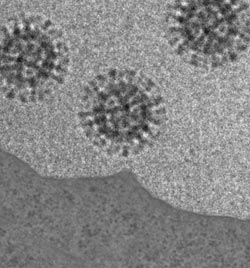Prevent influenza virus infections systematically

Influenza viruses close to a host cell<br>
Viral epidemics and pandemics remain a constant threat for human population. This impact was particularly demonstrated by the recent transmission and explosive worldwide spread of a swine origin influenza virus among humans and the ongoing highly lethal infections with avian subtype strains.
Influenza virus infections are a major cause for respiratory disease, which affect all age groups and can occur repeatedly in any particular individual.
The newly established research network “ViroSign – Systems Virology of Influenza – Molecular Signature of permissive Virus Infection” is an interdisciplinary project that combines different aspects of systems biology ranging from the global system-wide analysis of cellular proteins to high-resolution microscopy of single viruses and mathematical modeling.
The aim is to unravel the interaction network of each viral component as well as the signature of all cellular proteins (proteome) produced by the host-cell as a response to the pathogen. Experiments and theory will be directed towards the identification of cellular interactors and viral proteins responsible for a specific host cell response. Bioinformatics will build upon these results and integrate previous data on studies as the identification of host cell factors required for virus replication. “This identification will allow the construction of a systemic model of influenza virus host interaction and will be useful for making predictions for the specific design and application of drugs and inhibitors to prevent infection”, explains Andreas Herrmann, Professor at the Department of Molecular Biophysics at Humboldt-Universität zu Berlin and ViroSign Co-ordinator.
The project is funded with 1,94 Mill. € by the Federal Ministry of Education and Research in the frame of the program e:Bio. Teams with complementary expertise of different institution in the Berlin region are involved: Integrative Research Institute (IRI) for the Life Sciences at Humboldt-Universität zu Berlin (Prof. Dr. Dr. h.c. Edda Klipp, Prof. Dr. Andreas Herrmann (co-ordinator)), Max-Planck-Institute for Infection Biology (Prof. Dr. Thomas Meyer), Robert-Koch-Institute Berlin (PD Dr. Thorsten Wolff) and Max-Delbrück-Center for Molecular Medicine (Prof. Dr. Matthias Selbach).
Contact
Prof. Dr. Andreas Herrmann
Humboldt-Universität zu Berlin
Department of Biology
Phone: +49 30 2093-8830
Andreas.Herrmann@rz.hu-berlin.de
Media Contact
More Information:
http://www.hu-berlin.deAll latest news from the category: Life Sciences and Chemistry
Articles and reports from the Life Sciences and chemistry area deal with applied and basic research into modern biology, chemistry and human medicine.
Valuable information can be found on a range of life sciences fields including bacteriology, biochemistry, bionics, bioinformatics, biophysics, biotechnology, genetics, geobotany, human biology, marine biology, microbiology, molecular biology, cellular biology, zoology, bioinorganic chemistry, microchemistry and environmental chemistry.
Newest articles

Silicon Carbide Innovation Alliance to drive industrial-scale semiconductor work
Known for its ability to withstand extreme environments and high voltages, silicon carbide (SiC) is a semiconducting material made up of silicon and carbon atoms arranged into crystals that is…

New SPECT/CT technique shows impressive biomarker identification
…offers increased access for prostate cancer patients. A novel SPECT/CT acquisition method can accurately detect radiopharmaceutical biodistribution in a convenient manner for prostate cancer patients, opening the door for more…

How 3D printers can give robots a soft touch
Soft skin coverings and touch sensors have emerged as a promising feature for robots that are both safer and more intuitive for human interaction, but they are expensive and difficult…





















